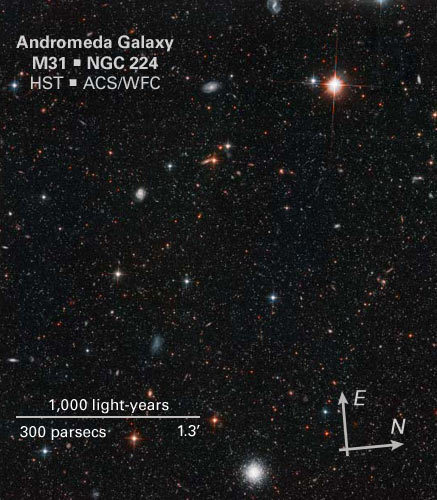1 min read
Young and Old Stars Found in Andromeda’s Halo

The deepest visible-light image ever taken of the sky resolves approximately 300,000 stars in the halo of the nearest neighboring spiral galaxy, Andromeda (M31). The photo was taken with the Advanced Camera for Surveys aboard NASA's Hubble Space Telescope. Because the image captures both faint dwarf stars and bright giant stars, astronomers can estimate the age of the halo population by analyzing its distribution of color and brightness. The halo is a spherical cloud of stars around Andromeda, located 2.5 million light-years from Earth.
The surprising result is that these stars span a wide range of ages, from 6 to 13 billion years old. The age range is much wider than that of the population of stars in the halo of our own Milky Way, where 11- to 13-billion-year-old stars reside. The presence of younger stars in the Andromeda halo is probably the result of a more violent history in the galaxy, due to mergers with smaller galaxies.
In addition to the field of halo stars, a globular cluster in Andromeda falls near the bottom of the image [the white, spherical object]. Due to the great depth of the image, thousands of background galaxies also can be seen through the veil of stars in Andromeda. One particularly interesting pair of galaxies can be seen on the right-hand edge of the image, about a third of the way from the top. They are a blue and a red galaxy crashing into each other. A pinwheel-looking spiral galaxy is nearby. A handful of very bright stars [including the one at upper right] are in the foreground, in our Milky Way.
The image was made from 250 separate exposures taken from Dec. 2, 2002 to Jan. 11, 2003. The total exposure time was 3.5 days.
The members of the M31 halo science team are: T.M. Brown, H.C. Ferguson, E. Smith (STScI); R.A. Kimble, A.V. Sweigart (NASA/GSFC); A. Renzini (ESO); R.M. Rich (UCLA); and D.A. VandenBerg (U. of Victoria)
About the Object
- R.A. PositionR.A. PositionRight ascension – analogous to longitude – is one component of an object's position.00h 46m 8.14s
- Dec. PositionDec. PositionDeclination – analogous to latitude – is one component of an object's position.40° 42' 36.36"
- ConstellationConstellationOne of 88 recognized regions of the celestial sphere in which the object appears.Andromeda
- DistanceDistanceThe physical distance from Earth to the astronomical object. Distances within our solar system are usually measured in Astronomical Units (AU). Distances between stars are usually measured in light-years. Interstellar distances can also be measured in parsecs.About 2.5 million light-years (0.8 Megaparsecs)
- DimensionsDimensionsThe physical size of the object or the apparent angle it subtends on the sky.The image is roughly 3.1 arcminutes (2,300 light-years or 710 parsecs) across.
About the Data
- Data DescriptionData DescriptionProposal: A description of the observations, their scientific justification, and the links to the data available in the science archive.
Science Team: The astronomers who planned the observations and analyzed the data. "PI" refers to the Principal Investigator.These data are from the HST proposal 9453 by T.M. Brown, H.C. Ferguson, E. Smith (STScI), R.A. Kimble, A.V. Sweigart (NASA/GSFC), A. Renzini (ESO), R.M. Rich (UCLA), and D.A. VandenBerg (U. of Victoria).
The members of the M31 halo science team are: T.M. Brown, H.C. Ferguson, E. Smith (STScI); R.A. Kimble, A.V. Sweigart (NASA/GSFC); A. Renzini (ESO); R.M. Rich (UCLA); and D.A. VandenBerg (U. of Victoria) - InstrumentInstrumentThe science instrument used to produce the data.HST>ACS/WFC
- Exposure DatesExposure DatesThe date(s) that the telescope made its observations and the total exposure time.December 2002 and January 2003, Exposure Time: 3.5 days
- FiltersFiltersThe camera filters that were used in the science observations.F606W (Wide V), F814W (I)
- Object NameObject NameA name or catalog number that astronomers use to identify an astronomical object.NGC 224, M31, Andromeda Galaxy Halo
- Object DescriptionObject DescriptionThe type of astronomical object.Spiral Galaxy in Local Group, Galaxy Halo
- Release DateMay 7, 2003
- Science ReleaseDeepest View of Space Yields Young Stars in Andromeda Halo
- Credit

Related Images & Videos

Postcards from Andromeda
Glittering stars. Distorted galaxies. A cluster of more than 100,000 stars. The celestial objects in this six-panel photograph are just a sampling of the more than 300,000 stars and the thousands of distant galaxies seen in the image of a small region of the Andromeda galaxy's...

Zoom into ACS Image of M31 Halo
A Zoom into the constellation Andromeda reveals the magnificent galaxy M31. Zoom continues to Hubble's Advanced Camera for Surveys image of a small portion of the M31 halo of stars. This spherical halo of stars surrounding the neighboring Andromeda galaxy has revealed...

Pan Across ACS Image of M31 Halo
Pan sequence of the Hubble's Advanced Camera for Surveys image of the M31 halo. The camera moves across various sections of the deep field, revealing myriad galaxies and stars. The complete Hubble view contains several hundred thousand stars and thousand of background galaxies.
Share
Details
Claire Andreoli
NASA’s Goddard Space Flight Center
Greenbelt, Maryland
claire.andreoli@nasa.gov







































